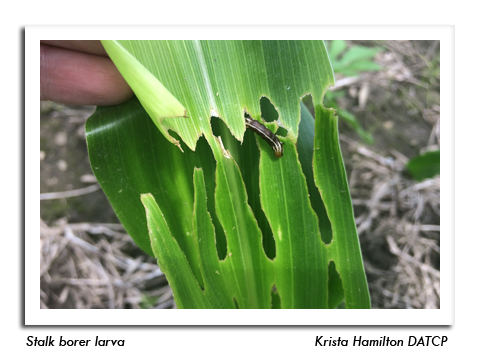
 |
|
|
Corn
Volume 56 Number 12 Date 07/14/2011 WESTERN BEAN CUTWORM - Below is a map showing the locations of 160 pheromone traps deployed as part of the annual trapping program. To date, one or more moths have been collected in 12% of the traps, as far north as Waushara and Wood counties. The high count for the period of July 8-14 was 11 in the black light trap near Sparta in Monroe County. Close inspection of corn fields for egg masses and small larvae should begin at this time. The eggs are deposited in groups of 5-200 on the upper leaf surface of the upper one-third of plants, and the larvae can be found in developing tassels. An economic threshold of 5% infestation for field corn and 4% infestation for sweet corn is recommended by the University of Wisconsin. Controls applied at 90-95% tassel emergence are most effective. STALK BORER - Larvae ranging in size from ¾-1¾ inches were noted to have caused extensive damage to the peripheral rows of corn at a few sites in Chippewa, Columbia, Eau Claire and Trempealeau counties. In one Chippewa County field, 56% of plants in the first row and 31% in the second and third rows were severely damaged. Spot treatment is no longer advised now that larvae have bored into the stalks and unemerged tassels and most corn is beyond the V7 growth stage. EUROPEAN CORN BORER - Pupation has begun in advanced areas of the state. Most first generation larvae are in the third and fourth instars, but development is variable. European corn borers in the east-central and northern areas are still in the early larval stages. Infestation rates in Chippewa, Eau Claire, Jefferson, Ozaukee, Rock, Sauk, Trempealeau and Walworth counties ranged from 1-19% in the past week. Seventy nine percent of sampled fields showed no signs of larval infestation and were presumed to be Bt hybrids. --Krista Hamilton, DATCP Entomologist .jpg)




|
|
|